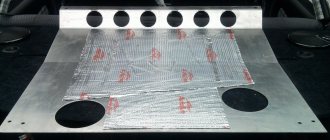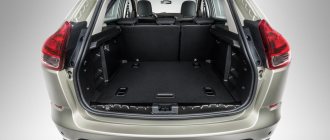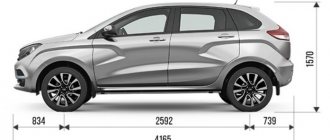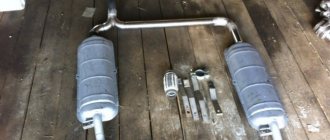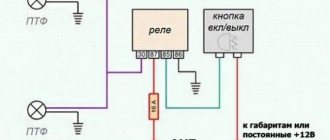The standard protection of a Lada Vesta car is a thin sheet, which, if hit well, will not cope with its purpose - this is typical for all AvtoVAZ cars. Therefore, you need to install thick protection - it will protect the engine from crankcase holes. Read the article and your car and you will be safe; the engine boot will never let you down. The engine compartment of the Lada Vesta is filled with almost all “vital organs”. The most basic thing that drives a car is the engine. For long-term, efficient operation, it is necessary to provide the motor with proper care and safety. The crankcase is made of soft material and is most susceptible to deformation and damage during impacts. Such breakdowns can cause car owners problems, wasted time and expensive repairs.
It is important to choose a crankcase protection adapted for the Lada Vesta. A broken power unit sump leads to oil leakage. If you turn off the engine in a timely manner, you may be able to limit yourself to replacing the damaged part. Continuing to drive with a broken oil pan will result in a major engine overhaul.
Standard protection of Lada Vesta
AvtoVAZ tried to adapt the new models of its lineup to the country's road surface as much as possible. Taking into account the maximum load, Vesta’s ground clearance is 171 cm, which is higher than that of a standard foreign car. The engine sump has standard protection (article 1 06029 1), which does a good job of limiting the impact of dust, water, and dirt on the engine compartment, but is unlikely to withstand serious impacts. That’s why people call it the engine boot, or the engine mudguard. One of the reasons why Lada Vesta owners refuse to install an engine protective shield is the reduction in ground clearance. Increased ground clearance will not protect the crankcase and gearbox from impact, but will make it possible to fix the part without causing inconvenience to the driver. Compared to the positive aspects for engine integrity, this minus is insignificant.
Possible consequences of the accident
Vesta's power unit sump is its weak point. After all, it is made from a fairly soft material and is not able to withstand impacts. Fortunately, if such an accident occurs in the city, there will be no problems calling a tow truck.
On our roads, a broken crankcase is not uncommon.
However, a broken crankcase will cause oil to leak from the engine. If the Vesta owner manages to immediately turn off the engine, most likely he will be able to get by with replacing only the crankcase, although this procedure is very expensive - purchasing new components and work will cost from 20,000 rubles. If it is not possible to immediately turn off the Lada engine, everything may end with a major overhaul of the power unit.
But an even more optimistic option involves obtaining a certificate from the traffic police (after all, this is internal damage), which means unnecessary red tape. In addition, the issue of the quality of the repairs carried out has also not been canceled. Even if all expenses are covered by the insurance company (if Vesta has CASCO insurance), next year insurance prices will be significantly increased.
After such an incident, the insurance company will probably increase prices.
However, things could be much worse. There have been cases when car owners have punctured the crankcase on the highway, far from the nearest city. In winter, in such a case, you will have to rely on the responsiveness of other drivers. The cause of an accident can be anything - from a pothole, to a piece of ice flying off a truck or a dropped load.
Pieces of asphalt can easily cause a broken crankcase.
Steel
This material is in greatest demand, since this option combines two selection criteria: price + quality. 2 mm thick steel sheets perfectly protect the crankcase. The average service life of steel protection is 7-10 years; in case of deformation, it can be easily restored. Such a part is optimal for Lada Vesta, due to its high rigidity and budget cost. Steel protection copes with its main functions, protecting the motor boat and gearbox from damage.
Many car enthusiasts prefer parts with stiffening ribs, believing that the ribs resist deformation by hard, cutting objects. However, there is also an opinion: at critical pressure, the crankcase will better protect a part with a smooth surface, evenly distributing the load. The main disadvantage is considered to be high susceptibility to corrosion, from which even powder coating and special application technology cannot protect.
Reviews
| № | Positive |
| 1 | Andrey (Avtodrom): I live in the city, the roads are good, I don’t need armor. |
| 2 | Sergey (Autotema): I bought metal protection, installed it myself, there’s nothing complicated about it. |
| 3 | Kirill (Autoreview): I’ve been driving a car with built-in armor for three years, no comments. I can’t say that the ground clearance has decreased significantly. |
| 4 | Alexey (Avtoria): a year has passed since the armor was installed, there are no comments, no creaks, no knocks. |
| 5 | Alexander (Drom): I’m happy with the purchase of protection, I often drive on the periphery, I don’t worry about the integrity of the engine. |
| 6 | Stanislav (Behind the wheel): the protection is good, practical, and does not deform. |
| 7 | Vasily Alekseevich (“5th wheel”): Three years have passed since installation, no complaints. |
| Negative | |
| 8 | Vitaly (Avtotema): the mount is not strong enough, sometimes it taps on uneven surfaces. |
| 9 | Svyatoslav (Otzovik.net): the price of original protection is unreasonably high. |
| 10 | Vlad (ProAuto): There are no particular complaints, but the quality of fastening can be improved. |
Reinforced steel
The reinforced version of the steel part has a thickness of 3-4 mm, the weight of the part increases, which significantly increases the load and fuel consumption. Reinforced steel is well suited for crossovers, such as the Lada Vesta Cross, since the large mass provides greater impact force. Restoring such a sheet is almost impossible, and the price is much higher. For maximum protection of the Lada Vesta crankcase, it is possible to use this option, however, drivers often opt for smooth steel in the first option.
Conclusion
Is crankcase protection necessary - definitely yes, for residents of the periphery, where the quality of the road surface is far from ideal.
The process of independently installing crankcase protection on a Lada Vesta car is not complicated, but it requires increased attention and strict adherence to the regulations.
If you encounter difficulties during installation, contact a service station specialist. Car service workers recommend purchasing branded car armor and then installing it, because only the “original” guarantees compatibility with the body structure of your vehicle.
Aluminum
The aluminum protection has a thickness of 5 mm, but this criterion does not affect its weight in any way, but is several times more expensive. The part has high strength and is easy to restore. Compared to other materials, aluminum has a longer service life. The properties of the metal make it possible to increase the dimensions of the part, which makes it possible to protect a larger area from impact.
Don't forget about car safety. The main advantage of the aluminum part is the absence of sparks upon impact, which protects the car from the risk of fire.
The downside of the part is its high susceptibility to oxidation, which significantly affects durability.
More details
52113 Standard Engine crankcase protection, gearbox. 1.5 mm, Steel.
- Material: 1.5 mm, Steel
- Manufacturer: AutoStandard
- Body: Sedan, station wagon
- Engine type: Gasoline
- Drive: front wheels
- Engine displacement: 1.6
- Features: Crankcase oil drain hole
- Full set weight: 6.757
- Dimensions: 760*1028
- Installation cost: 600 rub.
1200 o
Quantity
• To order
Order in 1 click By clicking on the button I give my consent to the processing of personal data
compare
array(34) { => string(1) "1" => string(1) "1" => string(31) "Car make" => string(1) "Y" => string(3) "500 " => string(13) "QV_AUTOMOBILE" => string(0) "" => string(1) "E" => string(1) "1" => string(2) "30" => string(1 ) “L” => string(1) “Y” => string(1) “1” => string(0) “” => string(1) “5” => string(1) “2” => string(1) "N" => string(1) "N" => string(1) "N" => string(1) "N" => string(1) "1" => NULL => bool( false) => string(0) "" => string(31) "Car make" => string(0) "" => NULL => NULL => NULL => array(2) { => string(6) "710147" => string(5) "25020" } => array(2) { => string(9) "150056535" => string(9) "150056536" } => array(2) { => NULL = > NULL } => array(2) { => string(6) "710147" => string(5) "25020" } => array(2) { => NULL => NULL } } Article 02104
Stainless steel
Stainless steel protection attracts car enthusiasts with its appearance - after all, it is stainless. There is no even minimal corrosion on shields made of this material. This option is most often preferred by drivers of jeeps/crossovers, but the considerable ground clearance of the Lada Vesta allows owners to choose this model. The strength of the steel sheet is high, as is the price, which is 2-3 times higher than ordinary steel.
An economical version of the protective shield is also popular - a regular steel sheet with a stainless steel overlay. This option allows you to significantly benefit in price, and the appearance remains at its best.
Preparing for theft when servicing a car.
The factory routinely installs fundamentally new anti-theft protection. Stealing a Lada Vesta requires serious technical training and modern equipment.
One of the most common methods of theft is the so-called preparation for theft when servicing a car. For example, during a wash or repair, the owner hands over the key and key fob. An attacker can quietly make an impression of the key, register a new key fob in the system memory and restore the starter circuit, blocked by the standard alarm, in a short period of time. After service, as a rule, car thieves do not immediately steal the car, but several days or even weeks later, in order to eliminate suspicion of a car service.
A good prevention against this kind of theft is to switch the alarm system to “Valet” mode. After carrying out the work, it is necessary to return the alarm to its original security mode. You should not give your car keys and key fob to service stations and car washes.
To protect the diagnostic connector, the connector re-pinning method or the OBD block system are used.
Ugona.net Blocking the OBD Block diagnostic connector RUB 9,000. Price with installation
The OBD BLOCK system is designed to protect the vehicle's OBD-II diagnostic connector from unauthorized access. Using the system helps prevent hacking of standard software when connected to the OBD diagnostic connector, etc.
Composite materials
Protection from composite materials: fiberglass, Kevlar or carbon fiber, is made by connecting them in layers using epoxy resins as a reinforcing link.
Such protectors are durable, light, completely free from corrosion and oxidation.
Taking into account the materials and binders used in production, the price of elements made of composite materials varies between a couple of hundred and several thousand dollars - so it is not for Vesta.
Due to complex production technology and lack of demand, restoring a damaged protector will become much more difficult. There is a high probability of purchasing a part with an internal defect that is difficult to detect with the naked eye.
Vesta and elastic bands from Solaris
Starting to study the systematic breakdowns that owners of the model experienced from time to time, it almost immediately became clear that a miracle had not happened - Vesta has plenty of weak points. First of all, I would like to talk about rubber products that wear out, tear, scratch and disturb the silence so actively that I had to devote an entire section to this topic.
Briefly about the quality of tires for a completely new car
It is recommended to replace standard windshield wiper blades with something more kosher immediately after purchasing a new car, otherwise in rainy weather you will have to look at the road through arched stripes. Little things, of course, especially when you consider that normal rubber bands can be bought for 150 rubles apiece, but, as you may have guessed, this is just the beginning. Vesta owners are also concerned about the side window seals, which, as they lower and raise, become covered with a scattering of “eternal” scratches, and in order to prevent this from happening so intensely, the friction points have to be often cleaned of dust and dirt and, for reliability, lubricated with everyone’s favorite “magpie” ( WD-40). We have already seen something similar in a used Kia Ceed JD.
And, of course, sounds. Even though this is far from the only source of noise for the Lada Vesta, it is still the stabilizer bushings that begin to creak earlier than anything else, since this happens in the very first stages of the semi-domestic beauty’s life. It is useless to lubricate and replace with the original. The best thing you can do is to break allegiance to AvtoVAZ and install the rubber bands of the main competitors, with whom Vesta so bloodthirsty “fought” on advertising posters - the brothers Hyundai Solaris and Kia Rio. Someone is adding parts from the Kia Soul and this also works in the battle for silence.
Sometimes you have to change bushings every 30,000 km, or finally fit rubber bands from a competitor called Solaris
Sometimes you have to replace the rear silent blocks of the front control arms with something imported, the rubber of which is accustomed not to crack and tear, but to immediately peel off from the holder. Moreover, the instability of quality has led to the fact that for some people this happens after only 50 thousand kilometers, while others drive a solid 100 thousand without replacement.
Tubes from the vacuum brake booster and systems for changing the length of the intake manifold also end up in landfills near garages. In the first case, a “hissing” from under the hood will help you understand what happened; in the second case, floating speed and poor starting.
This hose has already given in, disrupting the operation of the engine.
Finishing the topic of the total unsuitability of the rubber used in the Lada Vesta, one cannot ignore the exhaust gas removal system, that is, the muffler, which after the first year of operation “slides” down a couple of centimeters, bringing to motorists nostalgic feelings for the times when the pipe was hung on an air filter . At the same time, the old element ideally replaced sagging rubber bands forever, but Vesta, alas, does not have round filters and you will either have to reliably “collective farm” in another way, or just patriotically install the original every year
In this case, special attention should be paid to the condition of the intermediate corrugation, which has become one of the leaders in replacement during early car runs:
Torn corrugation
Manufacturers of crankcase protection
A wide selection of protective elements allows drivers to choose the option that best suits their vehicle. Lada 2180 owners give the greatest preference to the following manufacturers:
| Manufacturer | vendor code | Material | Thickness |
| Sheriff | 27.2928V1 | Steel | 2mm |
| Novline | NLZ.52.28.020NEW | Reinforced steel | 3 mm |
Helpful tips before you start washing
- First of all, it is necessary to dismantle all removable screens and plastic parts.
- Do not forget to cover information plates and inscriptions on all elements of the engine compartment.
- Monitor the engine temperature, which should be between 30-40 degrees before washing. When the engine is hot, the detergent will evaporate, and when the engine is cool, the effectiveness of the detergent will be reduced. It is desirable that the water temperature also corresponds to the specified standards.
- Disconnect the negative terminal of the battery, and pack the battery tightly in plastic. In the same way, carefully cover all connectors, terminals and all electrical equipment with polyethylene, which can be secured with tape.
Installation procedure for the protective element
Like any other product, engine protection has instructions for use. Which you must carefully read before installation and strictly follow the advice of specialists.
Replacing or installing a protective element yourself is not a difficult job; any car enthusiast can do it if he wants. You will need a room equipped with a car lift or a repair pit; in extreme cases, you can use an overpass. It should be remembered that when using two jacks, it is necessary to install safety stops for safety. The standard shield is secured with thirteen bolts; dismantling requires a standard set of wrenches. Before installation, clean and lubricate all holes and screws. Repeat the steps in reverse order and tighten the screws tightly.
Everything is ready for use.
Four minus one
What is completely unusual for the Lada Vesta is the fact that the line of units includes three engines and four different gearboxes with their own pros and cons and, what is even more interesting, three manual gearboxes and only one automatic, the well-known AMT. This is where we will begin our review of the weak points of the transmission.
It will not be a revelation to anyone that we don’t like “robots” for a reason. There are significant, sometimes very capacious in terms of the amount of swearing, reviews from the owners
And it doesn’t matter who developed the box, the Germans or the Japanese, there is only one conclusion - they are still far from ideal. This is especially true for the relatively cheap AMT with one clutch, which, in fact, was equipped with the budget Lada Vesta
It was not just anyone who worked on the Vesta clutch, but Sachs himself!
In short, the automatic transmission of the model consists of a VAZ gearbox, onto which the German ZF shift mechanism and Sachs clutch are “strung”. It's terribly stupid. It jerks, hangs on an unnecessary gear, or, on the contrary, shifts too early - all this is typical for a mechanism that cannot and will not learn to read your thoughts in the next decade.
Another “robot” under repair
If we add to all this the driver’s passionate disposition and refusal to periodically adapt the grip point, we get early clutch wear and, less often, worn-out synchronizers. Depending on the careful driving, clutches last an average of 80 tkm. Replacing the basket costs a little more than 15 thousand rubles, which is considered cheap for a “robot” and at the same time expensive for the owner of a Lada car. It’s easy to understand that the clutch is worn out - the car starts to shake like a “groove” when starting from a standstill and when switching.
Robot actuator under repair
The three remaining manual transmissions have almost no problems. Even the VAZ gearbox, mated only to the unit with the lowest horsepower, turned out to be reliable, although it was not distinguished by silence and clarity of operation. French gearboxes vibrate less and are better at selecting speeds, but they still howl, be it JH3, installed on the same motor, or JR5, mated to two more powerful units.
How to wash your car under the hood yourself?
Self-washing of the engine and engine compartment can be done using water and ordinary car shampoo. But it would be better to use a special cleaner, which is sold in any supermarket.
To properly and safely wash your car engine, follow the following action plan:
- Insulate all contacts with electrical tape.
- Warm up the engine slightly and turn off. To quickly and easily remove dirt and oil stains, the engine should be warm, but not hot.
- Disconnect the battery and remove it.
- Apply the foam cleaner evenly to the contaminated surfaces and leave to act for several minutes (according to the instructions).
- After time has passed, wipe the treated surfaces with a damp cloth. If available, you can use a home wash by setting the pressure to minimum.
After all the manipulations, wipe all surfaces dry, remove the insulation and let the motor dry thoroughly. The battery is cleaned separately, in the same way.
Important! It is prohibited to wash the engine under high pressure of water. Strong pressure can damage the seals, and water will begin to penetrate into the internal connectors
This will cause metal corrosion or cause water hammer!
Experts recommend speeding up the engine drying process by using a car vacuum cleaner. This way you can reduce the risk of contact oxidation. The procedure for washing the engine and engine compartment is very simple and does not require special skills. It is recommended to wash the engine no more than twice a year.
How to properly wash a car engine yourself
Washing a car engine with your own hands is not as simple a procedure as it seems. The fact is that a powerful jet of water can pierce the hood insulation; in addition, water in this case will penetrate into the spark plug wells, or under the rubber caps on the spark plugs. Also, a strong jet of liquid can rip off various covers and hanging elements located underneath.
If you do not have experience in washing the engine compartment, or you do not know how to wash a car engine with your own hands, you are better off going to a professional car wash. They have experience in performing the work and special equipment for this.
If you decide to remove existing contaminants in the engine compartment and properly wash the car engine yourself, you should adhere to the following algorithm of actions:
- First, you need to seal all the main components and assemblies of the motor so that water does not get into them. This is especially true for electrical wiring and the air filter. This can be done using plastic film and tape. It is necessary to cover all factory stickers placed on the engine.
- Then you need to clean the engine compartment from oil and dirt with a specially purchased chemical composition. To do this, a certain amount of these fluids is applied to the engine. In order for the chemicals to take effect, you need to wait the time specified in the instructions and then rinse off the detergents with a stream of water under pressure or steam under light pressure.
- When the washing procedure is completed, it is necessary to remove the protective film from the components and assemblies and thoroughly dry the engine compartment with compressed air. At home, this can be done using a regular hair dryer operating at less than full power. If you need such equipment, and you cannot quickly find a hair dryer, you can dry the motor with a vacuum cleaner.
- The work is completed by removing the resulting stains and drips using a microfiber sponge or suede cloth.
In addition to following the general algorithm of actions, you must also follow some separate rules on how to properly wash a car engine. The engine compartment should not be washed too often to avoid corrosion. It is forbidden to wash the engine when it is absolutely cold or too hot to avoid damage to the cylinder head. Therefore, the engine compartment is not washed in winter, and before starting the procedure, the engine is started and immediately turned off.
You should also not use water with a temperature above +10 degrees. Under the influence of high temperatures, not only engine elements, but also accessories made of plastic can deteriorate. For this reason, before starting the procedure, it is worth clarifying whether it is possible to wash a car engine with a Karcher.
Separately, it is worth mentioning that it is advisable to turn off the power to the car before washing it. The battery itself can be washed and dried outdoors. During the procedure, the battery terminals must be treated with a soda solution in a 1:1 ratio.

